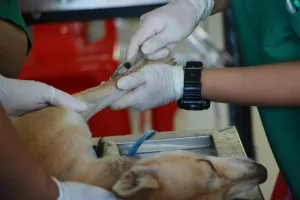Dogs have long been known as “man’s best friend” for their loyalty, companionship, and extraordinary abilities. Among these remarkable skills is their capacity to detect diseases, including cancer. The idea that dogs can detect cancer might sound like a scene from a movie, but it’s rooted in scientific fact. Over the past few decades, a growing body of research has shown that dogs can detect cancer with astonishing accuracy, even in its early stages. This ability has opened up possibilities for new, non-invasive methods of early diagnosis in humans, leveraging the extraordinary olfactory capabilities of dogs.
In this article, we will take a look into how dogs can detect cancer, explore the scientific studies supporting this phenomenon, examine the mechanisms behind it, and discuss the practical applications and limitations of using dogs for cancer detection.
How Do Dogs Detect Cancer?
The ability of dogs to detect cancer lies in their remarkable sense of smell. A dog’s olfactory system is one of the most sophisticated in the animal kingdom. While humans have around 5 million scent receptors, dogs possess up to 300 million. In addition, the part of their brain dedicated to analyzing smells is 40 times larger than that of humans, allowing dogs to detect incredibly faint odors that we can’t even begin to perceive.
Volatile Organic Compounds (VOCs)
Cancerous cells produce metabolic waste products that release volatile organic compounds (VOCs). These VOCs are emitted through the breath, sweat, urine, and other bodily fluids. Even in its early stages, cancer alters the body’s normal metabolic processes, leading to the release of these specific odors.
Dogs can be trained to recognize the distinct smell of these VOCs, which is how they are able to detect various types of cancer, including:
- Lung cancer
- Breast cancer
- Prostate cancer
- Colorectal cancer
- Ovarian cancer
- Melanoma
The key lies in the dog’s ability to pick up on these minute chemical changes and then signal their presence through specific behaviors, such as sitting, pawing, or barking.
Scientific Studies and Evidence Supporting Canine Cancer Detection
The idea that dogs can detect cancer is backed by numerous scientific studies. Let’s take a look at some of the most significant research that has validated this unique ability.
The First Major Study (1989)
The first documented case of a dog detecting cancer was published in The Lancet in 1989. In this study, a dog repeatedly sniffed a mole on its owner’s leg, showing intense interest in that specific spot. The mole was later diagnosed as malignant melanoma. This case sparked interest in the scientific community and laid the groundwork for more rigorous studies.
Study on Bladder Cancer (2004)
In a 2004 study published in the British Medical Journal, researchers trained six dogs to detect bladder cancer by smelling urine samples. The results were impressive: the dogs correctly identified the cancerous samples 41% of the time, far higher than what would be expected by chance. This study demonstrated that with proper training, dogs could reliably identify cancer-related odors.
Detection of Lung and Breast Cancer (2006)
A 2006 study published in Integrative Cancer Therapies explored the ability of dogs to detect breast and lung cancer by smelling breath samples. The dogs were able to detect lung cancer with 99% accuracy and breast cancer with 88% accuracy. These results were consistent across various stages of cancer, from early to advanced, highlighting the potential for early diagnosis.
Research on Prostate Cancer (2014)
In 2014, Italian researchers trained two German Shepherds to detect prostate cancer by smelling urine samples. The dogs achieved a 98% accuracy rate in identifying samples from patients with prostate cancer. This level of accuracy is comparable to, and in some cases better than, current diagnostic tests such as the PSA (prostate-specific antigen) test.
Early Detection of Ovarian Cancer (2019)
Ovarian cancer is particularly challenging to diagnose in its early stages because it often presents with vague symptoms. A 2019 study conducted by the University of Pennsylvania’s School of Veterinary Medicine showed promising results in using dogs to detect early-stage ovarian cancer. The trained dogs were able to differentiate between the blood plasma of healthy individuals and those with ovarian cancer with significant accuracy.
How Are Dogs Trained to Detect Cancer?
Training a dog to detect cancer is a complex process that requires patience, consistency, and expertise. The training usually involves the following steps:
1. Scent Association Training
The first step is to teach dogs to associate a particular odor with a reward, such as food or play. In the context of cancer detection, the odor is typically a sample containing VOCs emitted by cancerous cells.
2. Discrimination Training
Once the dog has learned to recognize the target scent, it is trained to differentiate between cancerous and non-cancerous samples. This stage involves presenting the dog with a variety of samples, only some of which are cancerous. The dog is rewarded when it correctly identifies the cancerous sample.
3. Generalization Training
In this stage, dogs learn to identify the cancerous scent across different environments, samples, and even in the presence of other distracting odors. This is crucial for ensuring that the dog can detect cancer reliably in real-world settings.
4. Confirmation and Reinforcement
Training is an ongoing process. Even after dogs reach proficiency, they undergo regular reinforcement training to maintain their skills.
The Mechanisms Behind Canine Cancer Detection
Although dogs have been proven to detect cancer, scientists are still unraveling the exact mechanisms that allow them to do so. The primary hypothesis revolves around the detection of volatile organic compounds (VOCs) released by cancerous cells. These VOCs are chemically distinct from those produced by healthy cells, allowing dogs to detect them even at incredibly low concentrations.
Olfactory Sensitivity
The olfactory sensitivity of dogs is their key asset. Not only do they have an extensive network of olfactory receptors, but their noses are also structured in a way that separates breathing from smelling, allowing them to continuously analyze odors even while inhaling or exhaling. Additionally, the large surface area of their nasal passages is covered with olfactory cells, which send detailed scent information to the brain.
Specialized Neural Processing
Dogs have a highly developed olfactory bulb, the part of the brain responsible for processing smells. The information gathered by the olfactory receptors is transmitted to this region, where it is analyzed and compared against known scents. This specialized neural processing allows dogs to detect and discriminate between different chemical compounds with incredible precision.
Applications of Canine Cancer Detection in Healthcare
While the idea of using dogs for cancer detection is promising, it also presents challenges and limitations. However, the potential applications in healthcare are numerous.
Early Detection and Screening
The most significant application of canine cancer detection is in the early diagnosis of cancer. Early detection is crucial for increasing survival rates, especially for cancers that are difficult to detect in their initial stages, such as pancreatic, ovarian, and lung cancers. Dogs could be used as a first-line screening tool, identifying individuals who need further diagnostic testing.
Complementary Diagnostic Tools
Dogs could also be employed as a complementary tool alongside traditional diagnostic tests. For instance, if a dog detects cancer in a patient whose conventional test results are inconclusive, it could prompt further investigation. This would be particularly valuable in cases where standard screening methods have high false-negative or false-positive rates.
Low-Cost and Non-Invasive Testing
One of the most attractive features of canine cancer detection is its non-invasive nature. Traditional diagnostic procedures like biopsies, MRIs, and CT scans are expensive and often involve discomfort or risk. In contrast, having a dog sniff a urine, breath, or sweat sample is painless and cost-effective.
Limitations and Challenges of Canine Cancer Detection
While the use of dogs in cancer detection holds significant promise, it’s essential to recognize the challenges and limitations that come with it.
Variability and Consistency
Training and maintaining a dog’s accuracy over time can be challenging. Dogs are living beings with moods, energy levels, and attention spans that can fluctuate. Consistency is crucial, and ensuring that trained dogs maintain their skills requires ongoing reinforcement.
Scalability
Another challenge is scalability. Training a single dog takes significant time and resources. Scaling this to the point where canine cancer detection can be used widely across healthcare settings would require substantial investment and a large number of trained dogs.
Ethical Considerations
Using dogs for medical diagnostics also raises ethical questions. While most dogs enjoy the work and find it rewarding, ensuring their well-being and preventing burnout is crucial. Ethical practices should be in place to ensure that the dogs are treated with care and respect.
Human vs. Dog Diagnostics
While dogs can be incredibly accurate, their use is not a substitute for traditional medical diagnostics. Dogs are better suited for initial screenings or as complementary tools rather than being relied upon exclusively for a diagnosis. It’s important to consider that false positives and negatives can occur, just as with human-administered tests.
The Future of Canine Cancer Detection
The future of canine cancer detection is exciting, but it will likely involve a combination of canine and technological advances. Researchers are exploring how to replicate dogs’ olfactory capabilities using technology. The development of electronic noses, devices designed to mimic the olfactory sensitivity of dogs, could one day provide a scalable solution for cancer detection.
In the meantime, canine cancer detection is already making an impact in research and preliminary screening programs. Hospitals, research institutions, and even some veterinary practices are exploring how to integrate trained dogs into their diagnostic processes.
Conclusion: The Remarkable Abilities of Our Canine Companions
The notion that dogs can detect cancer is no longer just anecdotal; it’s supported by a growing body of scientific evidence. The ability of dogs to sniff out cancer, sometimes even before conventional diagnostic methods can,




